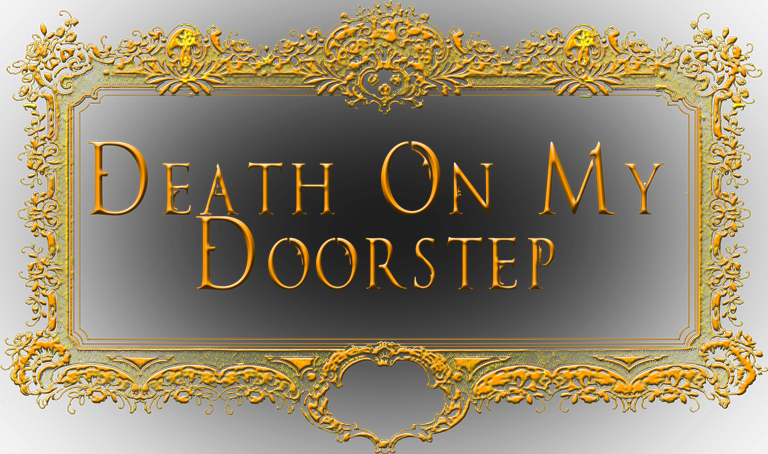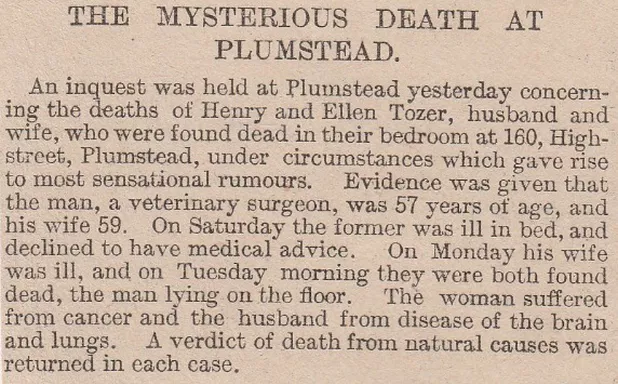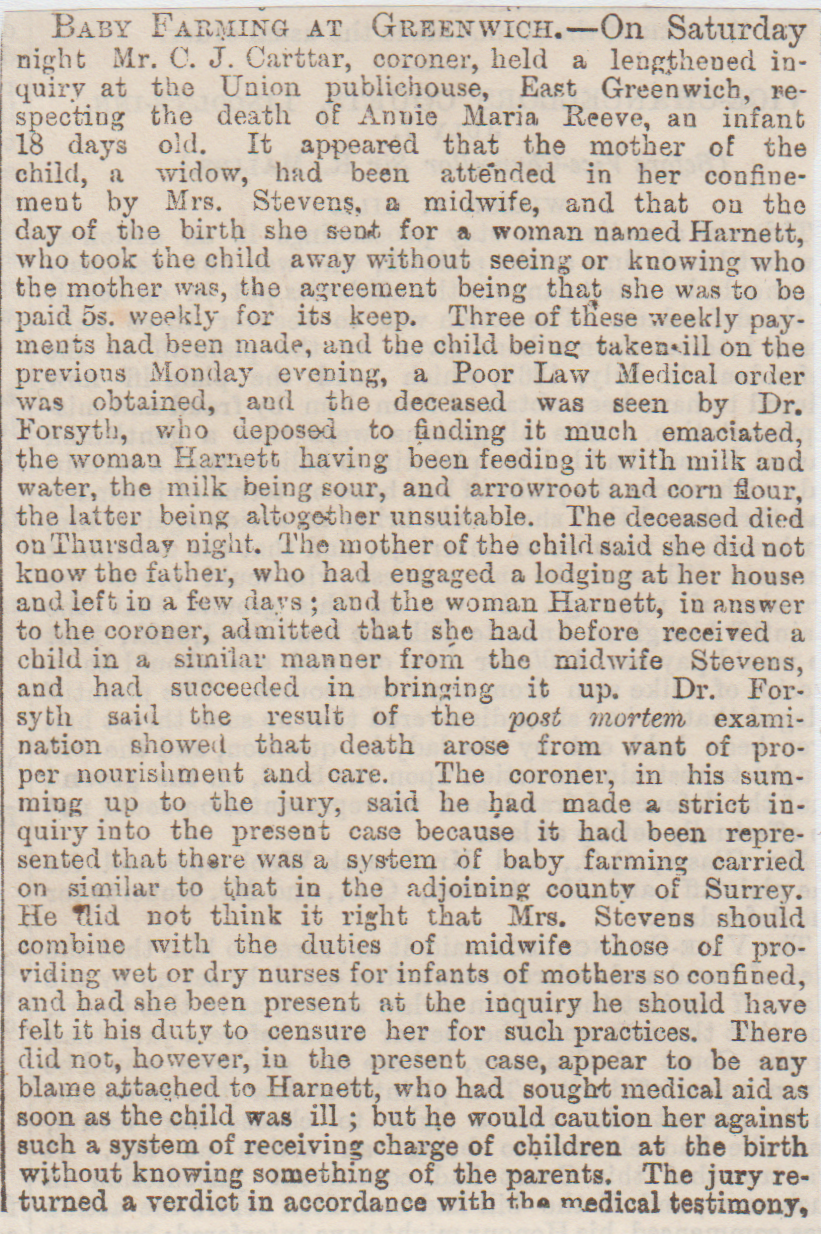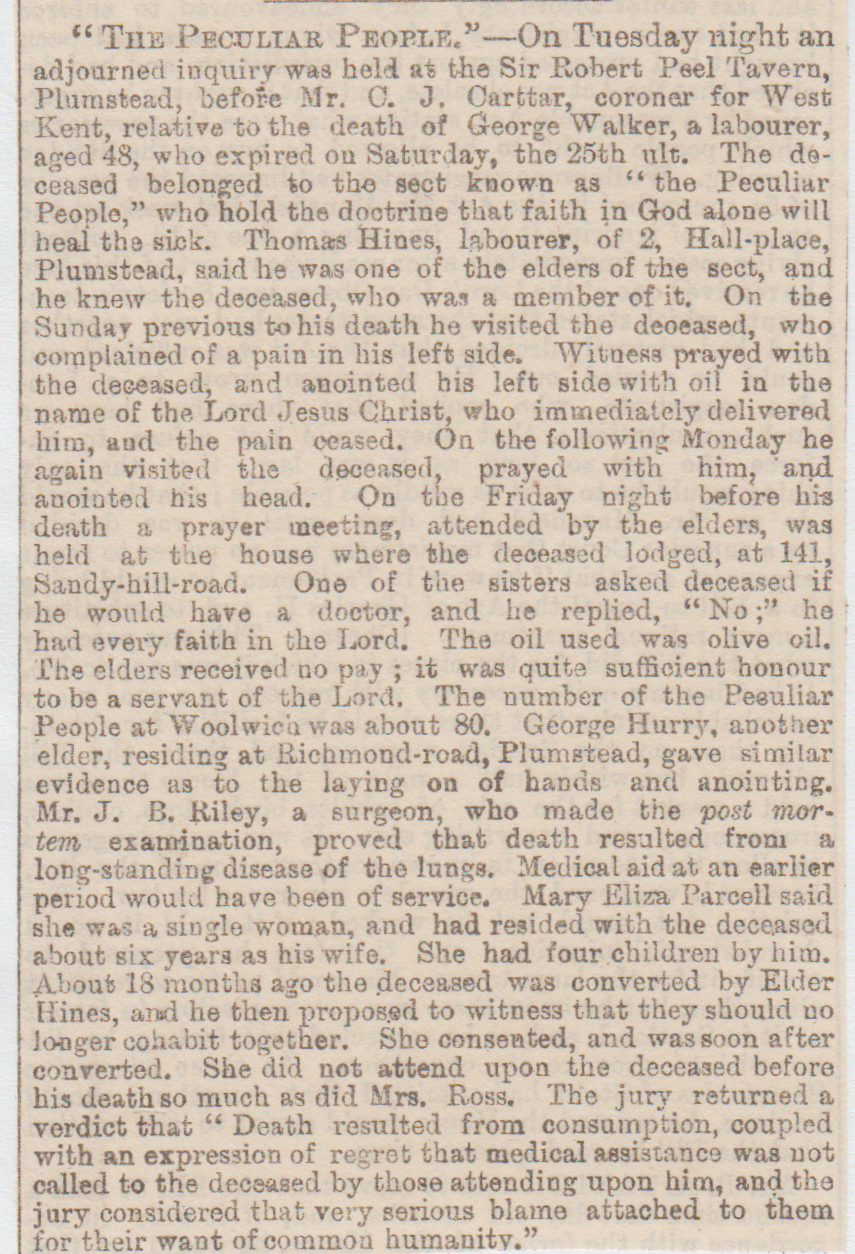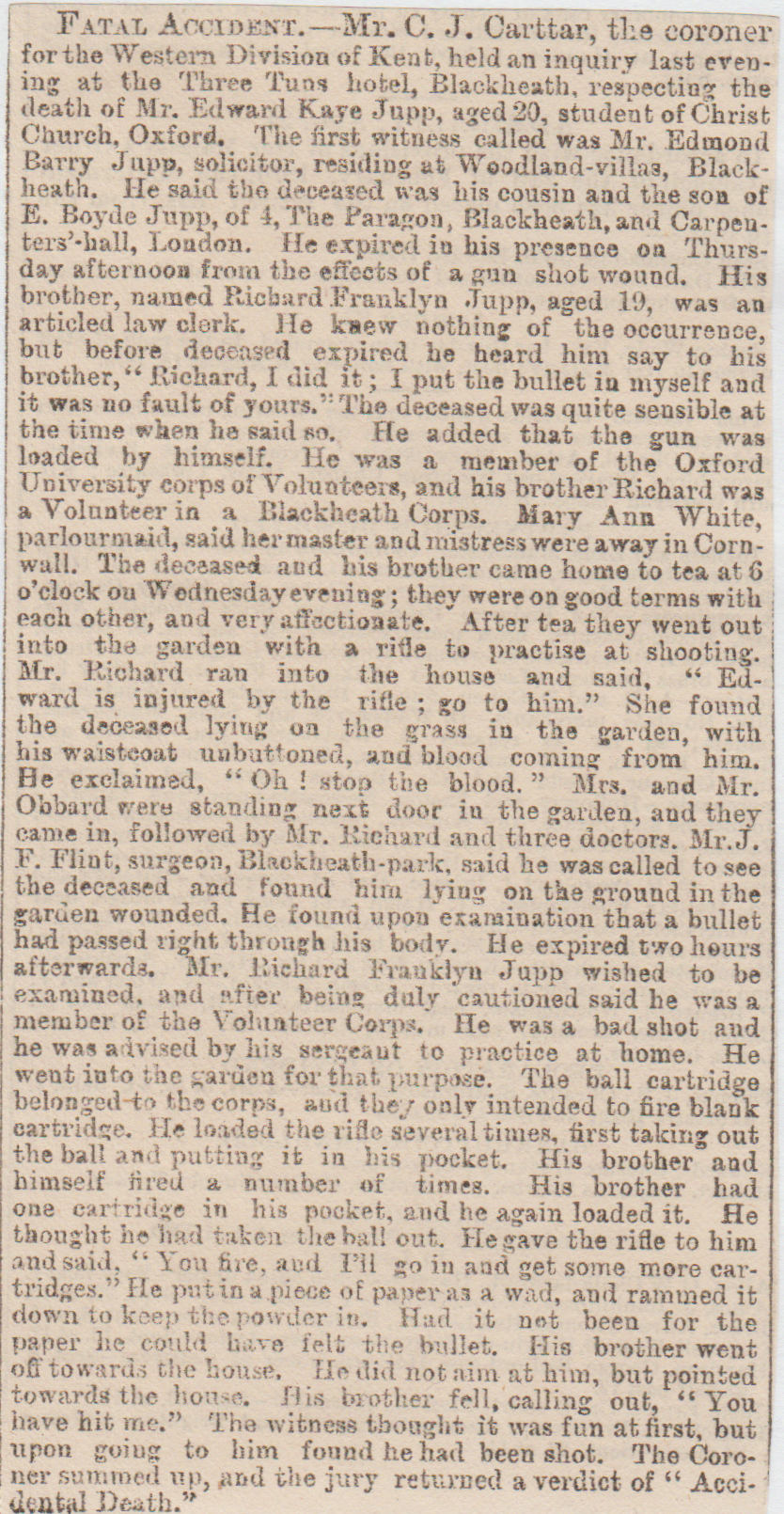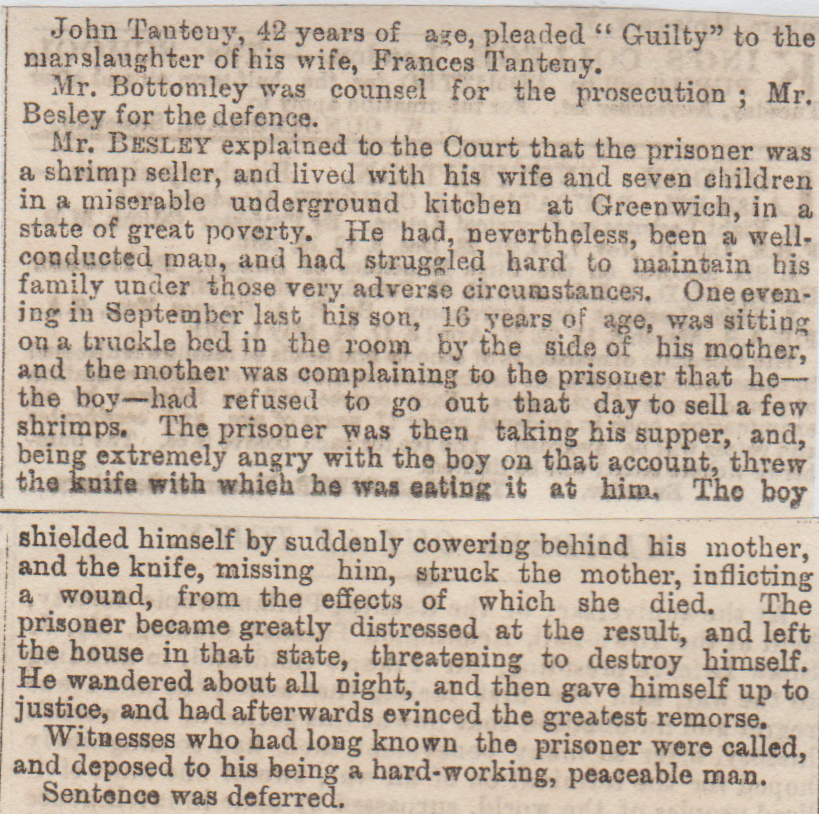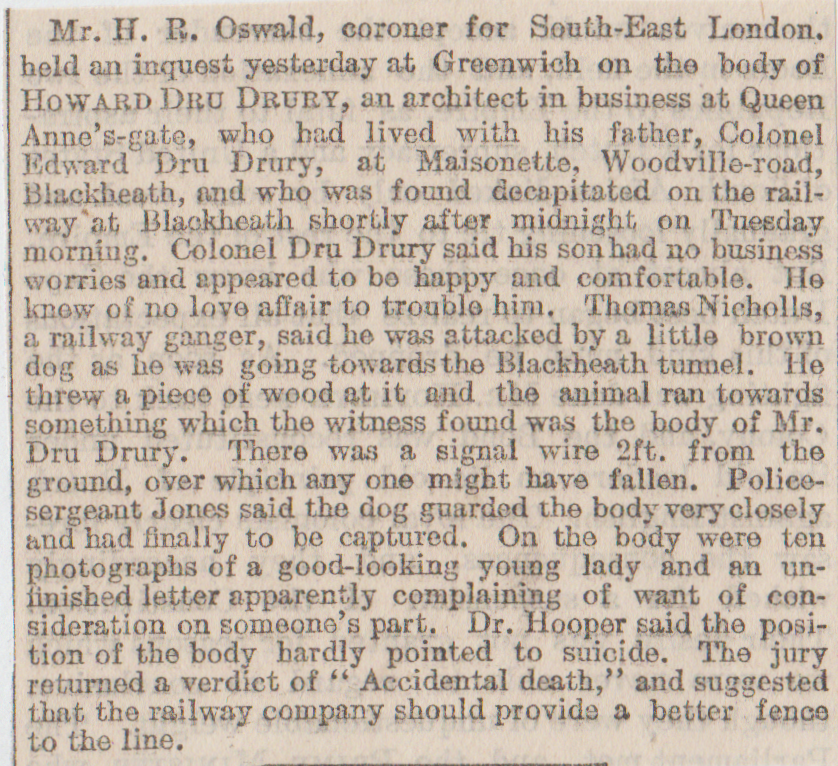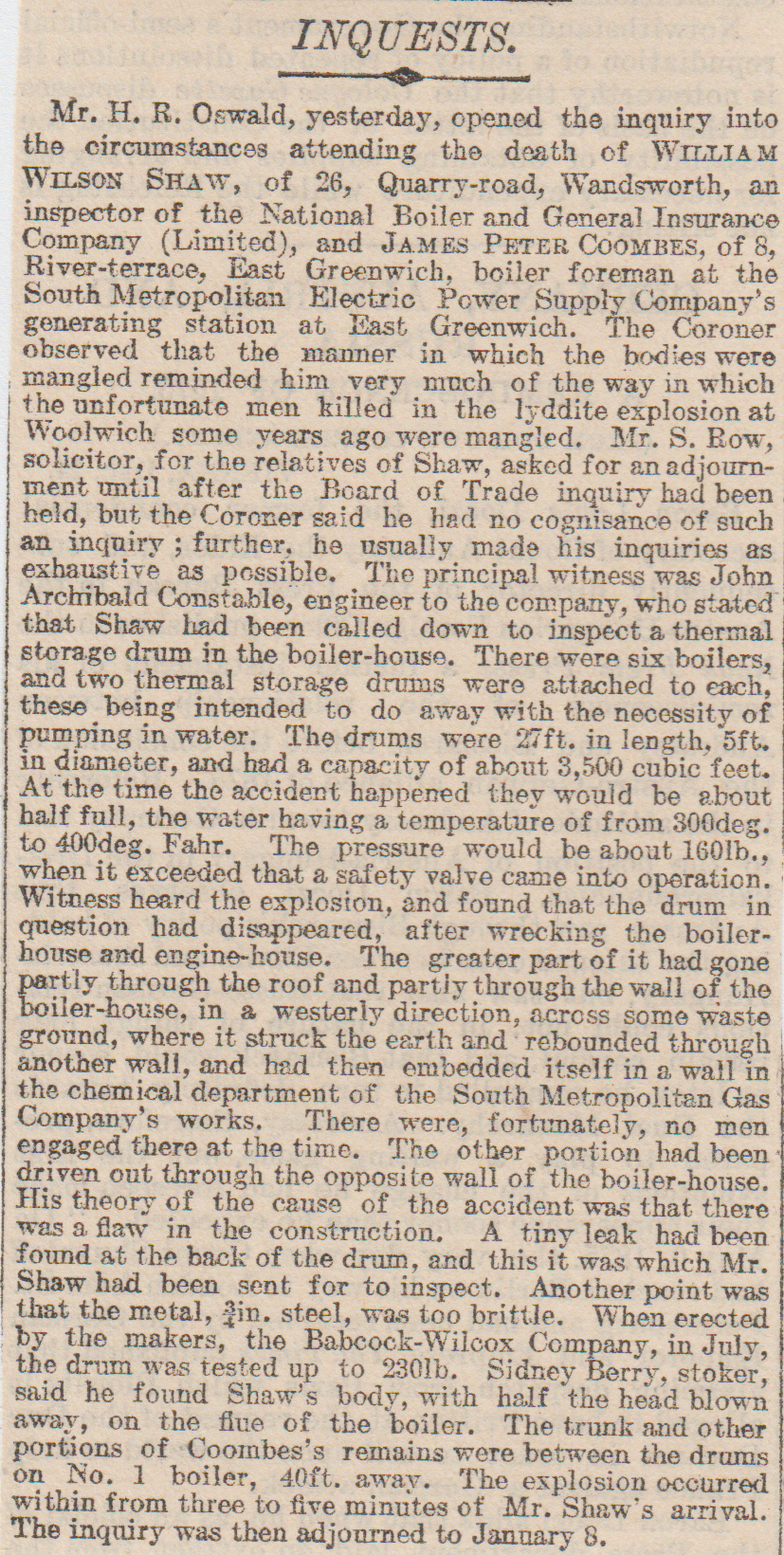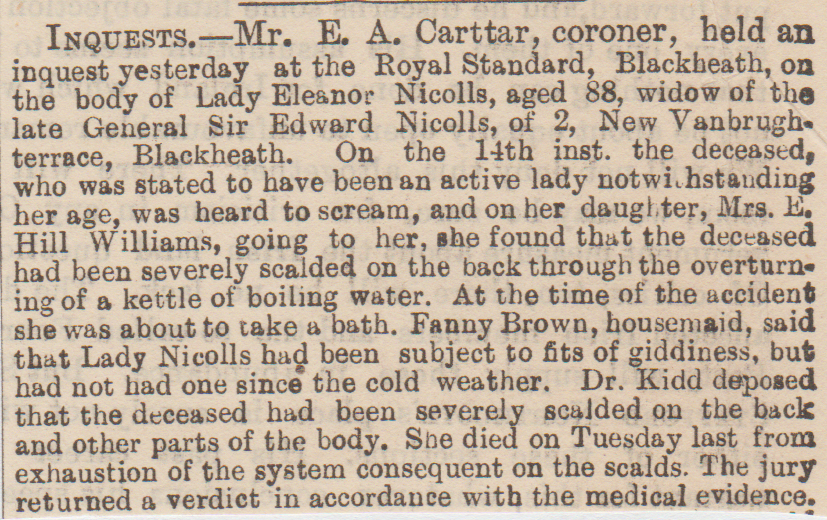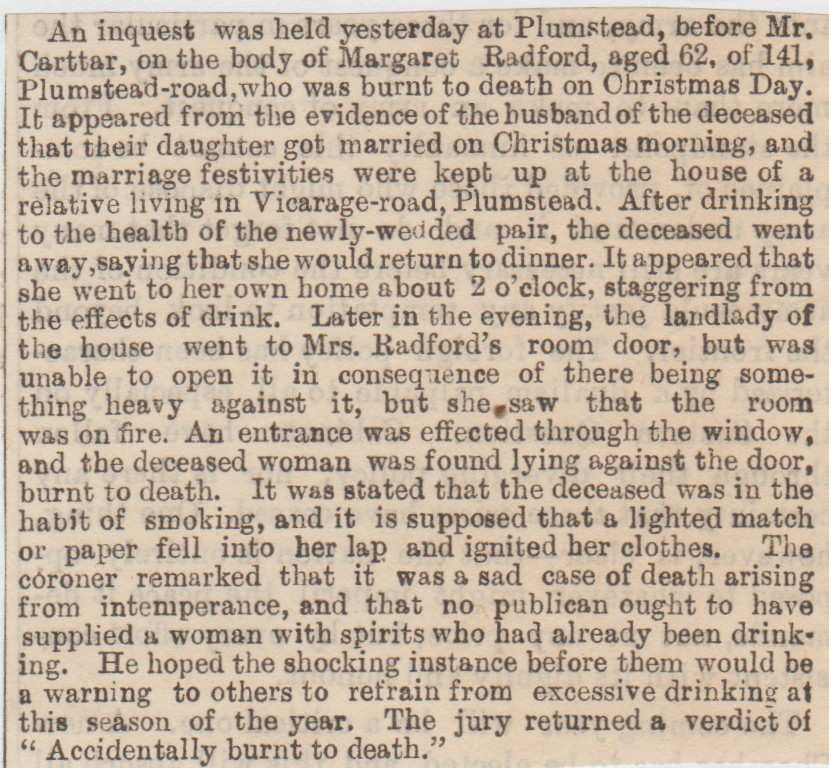1/ Charlton Cemetery Death, January 1906
A grave-digger at Charlton Cemetery, went down into a grave to check his work and a pile of earth gave way and he was buried. Eventually, the grave-digger, William Paisley of Eltham Road in Eltham, was dug out of the grave, but he was quite dead.
2/ Greenwich Skeletons, December 1872

I know it’s not the picture that should be there, but it’s the only one I had of Greenwich. This clipping refers to some workmen who were converting Greenwich Hospital into a naval college (could be the one !), they found a couple of skeletons underneath the stone-flagged floor of what was once the Royal Palace of every Englishman’s favourite obese dictator, Henry the Eighth and Queen Elizabeth 1st. They also found an underground passage, approximately half a mile long, as well as the two skulls and various other bones. It was supposed to be a section of another passage that ran from an old house near Eltham Palace to another ancient residence, recently demolished, near the site of the Greenwich Palace. Back in the real world, it was found to be the sewers of a hospital. (Where are the skeletons now?)
3/ No.18, Waterman’s Fields, Woolwich, (Singular Suicide) October 1884
A 55-year-old pensioner, George Thomas, residing at 18, Waterman’s Fields killed himself in a bizarre manner one afternoon. The weird thing about this was that Thomas had just been up in court on a charge of attempting suicide. The judge took a lenient view and let him off as long as he promised not to do it again. Thomas promised and walked out of court a free man. While sat at home he grabbed a bottle, popped it into his mouth and started to chew on it. The shards of glass cut his jugular vein and caused haemorrhaging. He died from these injuries, and due to the odd way in which he killed himself, the jury decided that he must have been insane. ( N* Sh*t Sherlock.)
4/ Woolwich Arsenal Explosion, June 1899
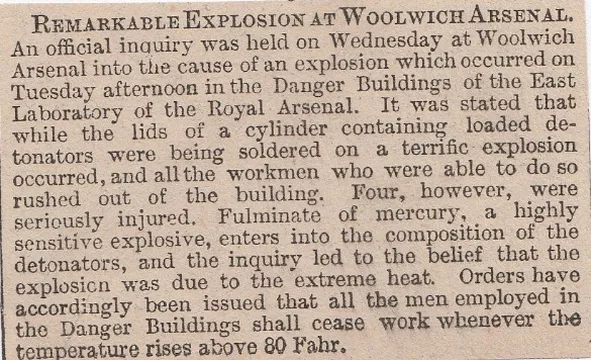
5/ Royal Arsenal Suicide, Woolwich, April 1872
William Holmes was a pensioner from the Royal Artillery, who worked at the practice range at the Royal Arsenal, Woolwich. He used to fire the rifles at the 500-yard range, at the Government marshes next to the Royal Arsenal, for the purpose of testing the cartridges. One afternoon he sneaked off into one of the sheds and closed the door. A couple of minutes later there was a loud report of a gun, then some workmen scrambled across to the shed to see if Holmes was alright. They opened the door and found him sat down with the top of his head blown off and half his face missing. The Snider rifle he used was lying next to him, and it had a piece of string tied to the trigger.
6/ Plumstead, April 1857 (Acrobatic Death)
In Victorian times it was common to see acrobats, tumblers and balancers in the streets performing some kind of act. It was these gymnasts that cost 6-year-old William James Jewell his life. Two such acrobats, Parish and Evans were rolling and tumbling and were about to climb a pole that they used in their act, when it accidentally slipped from their grasp and smacked Jewell on the head. He was unconscious and never came out of it, dying a few hours later. The jury questioned why such cumbersome objects were used in street performances and gave the following verdict: “Death was caused by the incautiousness of the two men, Parish and Evans”.
7/ Woolwich Arsenal, (Fatal Explosion) April 1892
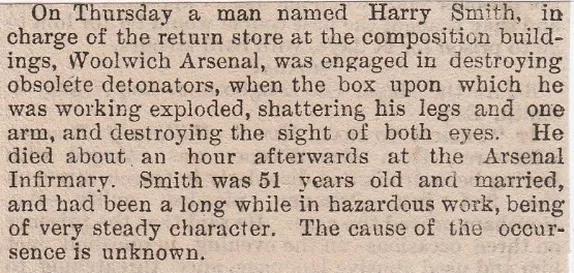
8/ Park Place Suicide, Greenwich, May 1843
Mr Smith, who was a county magistrate, killed himself at his home in Park Place, Greenwich. The reason? Corruption? Illness? Being Blackmailed? Love? No. It was the belief that he had filled out his tax return wrongly. The man was extremely wealthy and he told his doctor of his worry, but the verdict, in the end, was “Temporary Insanity”.
9/ King John’s Palace, Eltham, May 1893 (Body in Moat)
The body of an unknown lady wearing valuable jewellery was fished out of the moat at King John’s Palace in Eltham.
10/ Woolwich, May 1847 (Child Murder/Suicide)
An awful act of child murder and self-destruction occurred on the River Thames. The young woman named Robinson, vaulted overboard from the boat, Salsette, with her 15-month old child clasped tightly in her arms. A brave chap on board the Salsette dived in after her and tried to save her and the baby. Sadly he was too late, and the pair sank to the bottom.
11/ Cottage Place, Maidenstone Hill, Greenwich, January 1859
Ellen Wallis was a widow living at 18, Cottage Place, Maidenstone Hill in Greenwich, committed suicide by drowning herself in a tank of water at the back her house. The previous night she had gone to bed with her 9-year-old son, and when he woke up at 5 o’clock in the morning when he found that Mummy had gone away. He looked in the house, but when she was nowhere to be found, a full-blown search was made. Wallis was finally discovered in the water tank with a flat-iron tied around her neck. She was 50 years old and there is no reason why she would have committed suicide in the middle of the night.
12/ Dandridge’s Wharf Murder, High Street, Woolwich, March 1892
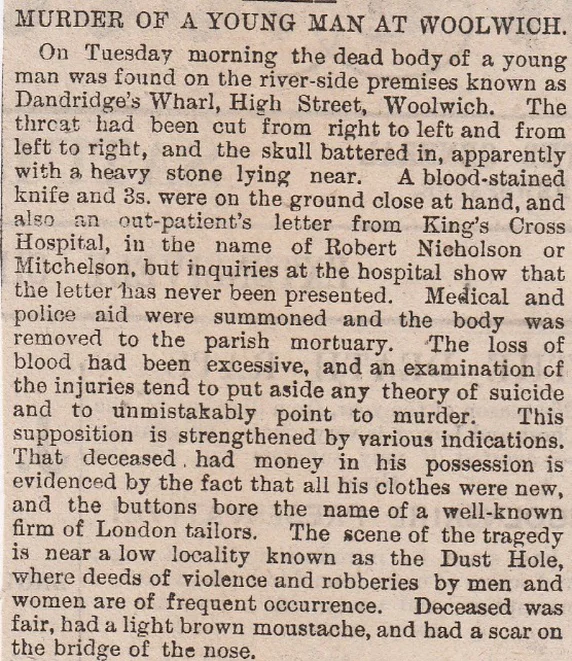
13/ Woolwich Barracks, (Corpse Found) June 1880
Thomas Humphries, a soldier, entered an empty wash-house which lay beneath “C Block” of the officers quarters of the Army Service Corps Barracks in Woolwich. His dog began to scratch at some lime on the floor, then it dragged a girl’s body out which had a bunch of faded flowers on her chest. Who the girl was, is a mystery, but is now being investigated by local police.
14/ Ogleby Street, Woolwich, November 1888
Police forced an entry into a locked room at Ogleby Street and discovered the limbless body of a child. The last person who rented the room, who was twenty-two-year-old Lily Smith, a half-starved single woman, was arrested. She told police that she had burnt the arms and legs and that the father of the child was a soldier with whom she co-habited.
15/ Warspite training ship, Charlton, Greenwich, November 1869
A young boy named George Dodson hung himself while on board the Warspite training ship. Dodson’s father said that his lad liked the training ship a lot and he’d only been home once while he had been on board the Warspite. There was a history of suicide in the family since his grandfather hung himself, his great-grandfather had jumped in front of an engine and his uncle had laid down on the train tracks when an engine was approaching.
16/ High Street, Plumstead, April 5th, 1899 (Mysterious Deaths)
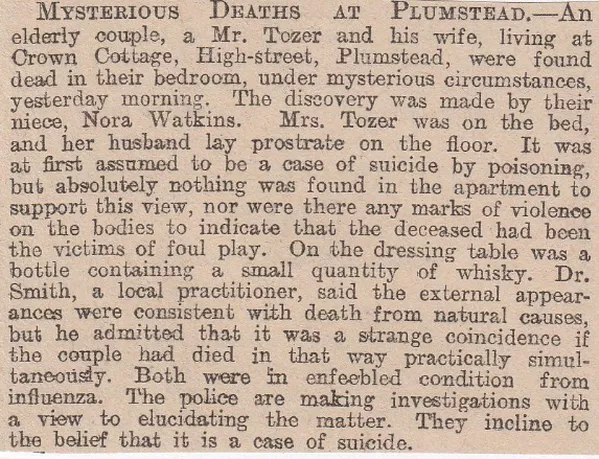
17/ Death on the High Street, Plumstead, April 6th, 1899
18/ Shooters Hill Suicide, November 1889
The body of a young lady named Carter, who lived at Shooter’s Hill, was discovered in a pond at the top of the Hill. Her hat, jacket and gloves were laid neatly on the side of the bank, so she must have drowned herself. Carter’s mind was somewhat disturbed and she had been put on suicide watch in case she did something stupid or rash. She went out one morning, to visit a friend of hers, but she never turned up there. The servants went to look for her and eventually, the gardener saw her floating in a pond, which is in an enclosure belonging to another owner, but close to her father’s property.
19/ Nile Street, Woolwich, October 1885

20/ Selcroft Road Suicide, East Greenwich, July 1896
A shocking discovery was made at Selcroft Road in East Greenwich when the badly decaying body of a young woman was found hanging on the door of a room there. The remains were identified as those of Mrs Waight, wife of a marine engineer, who is currently working somewhere in the Mediterranean. It looks like suicide but although it looks like an open and shut case, the couple were not on good terms as they often physically and verbally abused each other. The corpse had been there for ten days, and it was her mother that found the body in its current state.
21/ Suicide in the Royal Naval & Military Repository, Woolwich Common, September 1875
The cadaver of a young woman was found by a group of soldiers in the Royal Naval & Military Repository at Woolwich Common and was found to be that of 16-year-old Anne Louch, daughter of a gunner in the Royal Artillery, who was himself drowned numerous years ago. Anne had gone missing a few days ago and her mother found her with a married bandsman one day and reprimanded her for her behaviour. The threat was ignored by her and later on that evening she was still in his company. The strange thing about her supposed suicide is that she would have had to scale a high wall to get into the Military Repository grounds, as the entrances are guarded.
22/ Eltham Outrage, September 1885

23/ Woolwich Suicide, July 1886
A garrison policeman named Hardiman killed himself after making an attempt to shoot his sergeant. He had a feeling of revenge for days against Sergeant Coffee, who had reprimanded him for being negligent while on duty. Hardiman bought a revolver then made his way to the sergeant’s quarter’s, and while on his way up, Coffee saw him and quickly bolted the door. He hung about for a while then went back to his residence and shot himself in the head, in front of his wife.
24/ Woolwich Murderess, April 1885

25/ North Woolwich, March 1879 (Romantic Suicide)
Two bodies of a man and a woman were fished out of the River Thames near North Woolwich, with him being identified as Charles Gifford aged 42, residing at 23, Marine Parade, Brighton, and she was Miss Blanche Crossfield from Horsham in Sussex. In a romantic tale that could be straight from a Mills and Boon, it was discovered that the two became acquainted with Miss Crossfield aged 17, and he having rescued her while she was drowning. They kept seeing each other after the event and fell in love and wanted to get married, but Mr Crossfield withdrew his promise of marriage as he found out that Charles Gifford was a Roman Catholic. The couple agreed to not get wed until Mr Crossfield withdrew his objection. Charles went away for numerous years to Greece, Germany and Switzerland, when he received a letter from Mr Crossfield saying that his daughter was dying and that he blamed Gifford as being the cause. He also stated that “If you wed my daughter, my curse shall follow you both, I have already disinherited her”. Gifford went down to her home at Gravesend, with Mr Crossfield being killed in a carriage accident. When found, the couple were tied together with silk cords, and a piece of card bore the words:- “As we may not be wed in this world, may heaven permit us in the next. In loving embrace, we mutually agree to leave this selfish world-Signed Charles Gifford, Blanche Crossfield- February 8th, 1879 ”
26/ Greenwich, (A Sister’s Love) September 1885
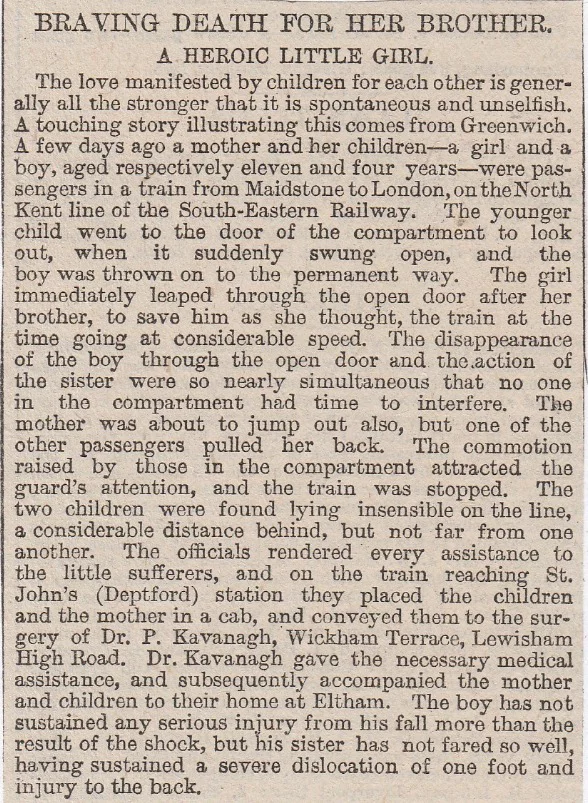
27/ Greenwich, June 1830 (Victorian Toy-boy)
Mary Ann Knowles was a 69-year-old widow, whose husband, Major Thoits of the North York Greys, had left her extremely well off after his death. Tongues were wagging in the borough of Greenwich when they read about her and a certain attachment to a 21-year-old toyboy. Just after he died she went on a trip to the continent where she shacked up with this young lad named Knowles. It is safe to say that she fell head over heels for him, but clearly, he was using her to gain access to her large fortune. She asked him to travel around Europe with her under the guise of being her nephew, and to this little arrangement, he agreed. When asked about family background he fobbed them off with a tissue of lies saying that he was the son of a governor of a fort at Guernsey and had been left some property by his uncle. As time went on she became more and more infatuated with the lad, so much so, that she proposed marriage to him. This would be great news for him; a nearly seventy-year-old missus, not long to live, who owned a fortune he could only dream of. He agreed to this and in December 1829 they were married at Milton church near Gravesend. After the marriage, he became violent towards her. Well, he’d got her where he wanted her, and she was frequently seen with bruises and a black eye once in a while. He would parade around with a young woman of his age and much more gorgeous than she was. One day Knowles went too far when he beat so savagely, that she applied to a magistrate and took an old-fashioned restraining order against him, and this threat of the law coming down on him seemed to calm him down. Mary Ann, on the other hand, was distraught. One morning her servant walked in to find her sitting on the ground at the foot of the bed with her head tilted forward. On lifting her up she found some green cord tied around her neck, and she was quite dead. It appeared that a carpet bag (the mouth of which was drawn together with the cord) was hanging to a brass knob on the closet door, about four feet from the floor. She is thought to have put her head through the loop then twisted it around her neck then put herself in a sitting posture till she strangled herself.
28/ Plumstead Marshes, Woolwich Arsenal, September 12th, 1885
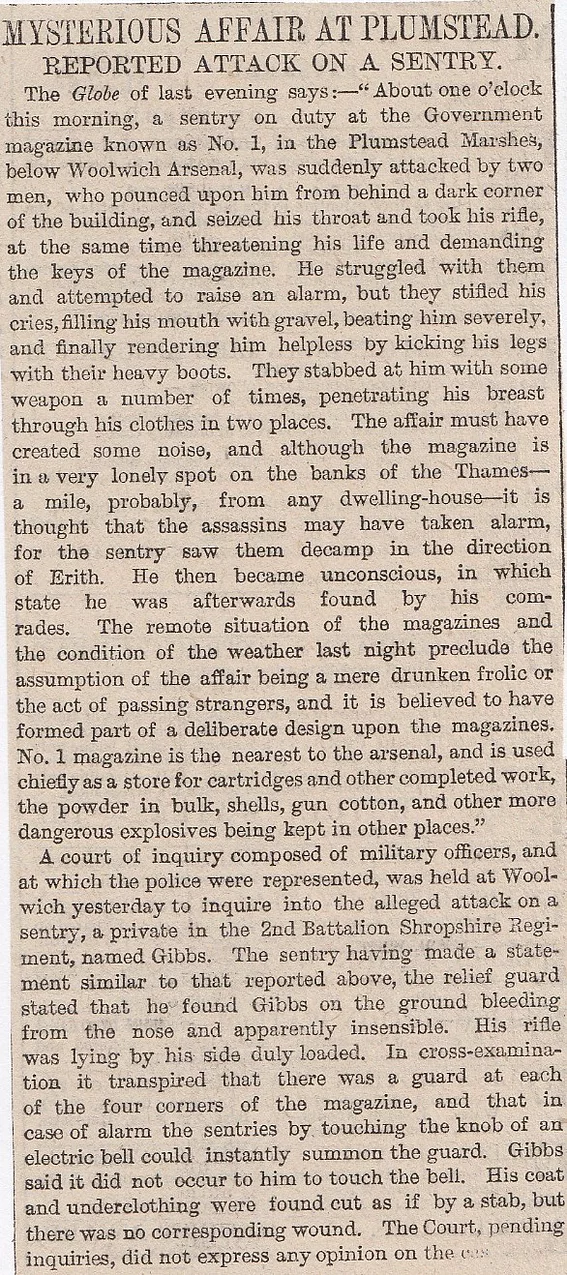
29/ Plumstead Marshes, Woolwich Arsenal, September 14th, 1885

30/ Charlton Murders, May 1901 (Father Kills Five Children)
An awful domestic tragedy occurred in Charlton when it was discovered that a father had murdered five of his children. The man in question is Thomas Butler Cole Butter, who is a quartermaster-sergeant in the Army Service Corps and had been stationed at Dover, had just arrived at Woolwich to prepare for the front. Neighbours heard screaming one evening, then repeated gunshots at various intervals, so they called the police. When they arrived at the multiple murder scene they found all six children had been shot. Five were dead and one girl clung to life. Police grabbed him but he offered no resistance whatsoever, and he was taken to Woolwich Police Station and said nothing while in the cell. The wife had been out of the house at the time, her deceased children are Gladys,12; Hilda,10; Grace,8; Edric,4; and little Vera aged 2. The seriously wounded one, 13-year-old Lily, lies in a precarious condition.
31/ Woolwich Soldier Murder, February 9th, 1885

32/ Woolwich Soldier Murder, February 11th, 1885

33/ Woolwich Suicide, December 1878
The day after Boxing Day, the body of Mr Eastlake from Ladbrook Grove Road, Notting Hill, was discovered in the Thames near Woolwich, and the story of how he came to be there and of his life, is an amazing one and will pan out later in the story. The bargeman on the “Lucy Darling”, saw an overturned boat a couple of miles from Woolwich. He went to see if anyone was clinging to it but it took him, and his wife and cabin boy, to turn it right side up. It was found that a rope was tied to the seat and a heavy weight was thrown into the water, which explains why they struggled to turn it over. The weight was pulled up and Mr Eastlake was attached to it. He left a few letters, one of which was addressed to Mr C. Wyatt-it read as follows:-
“November 18th, 1878, London-My Dear Charley, you know my old fad, and you may think as you please, but I know it is to be discovered; however, although it is so, I will carry the search no further, but keep the promise to take the alternative step-suicide, and you need none of you grieve, you will be fool’s if you do, as I die with the greatest glee, knowing I shall be tormented no longer by the riddle. Wishing you all joy at Christmas, your affectionate cousin, Alfred”. The word “Deceased ” was written all over the letter, proving it had been through the Dead Letter Office. Another went to a brother at Surbiton who came and identified the body at Woolwich and told police that he tried to kill himself in the exact same way last Christmas, but failed. He also told them that he inherited a large fortune aged twenty-one, and now forty-five, he had a country lodge in Sussex. He collected curiosities and antiquities and told his brother that when he found out the things he wanted to and seen the places he wanted to visit, he “would part with life”. In another letter, he tells the reader that he was determined to commit suicide this time by filling his coat pockets with stones and several granites. Brother also said that he was somewhat of a hermit in his living arrangements.
34/ Woolwich, (Laura Wilson Murder) January 9th, 1885
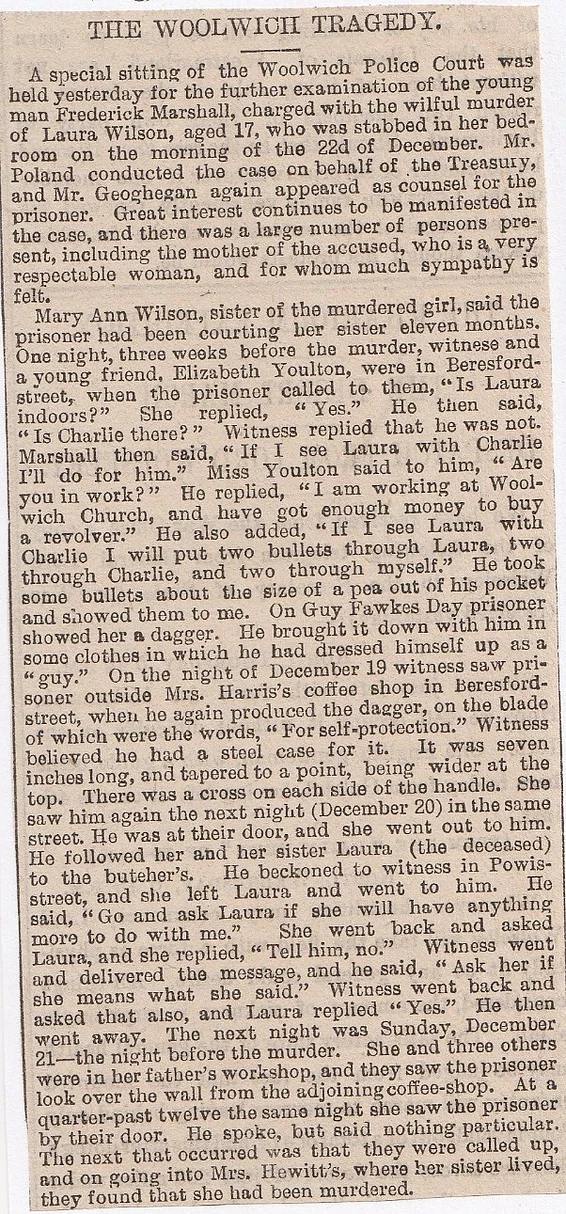

35/ Woolwich, (Laura Wilson Murder) February 2nd, 1885
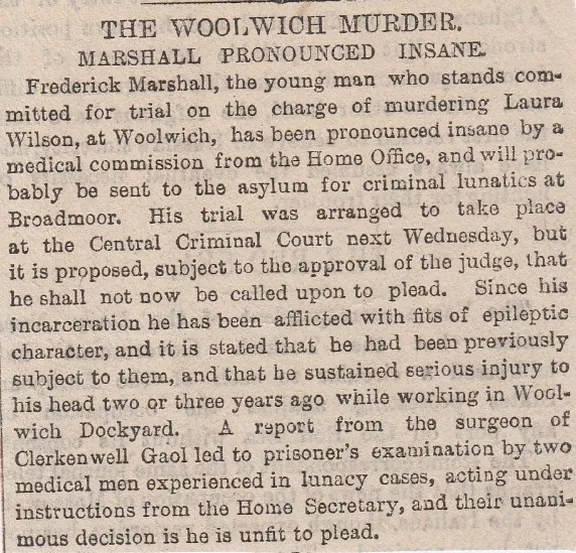
36/ Woolwich, (Laura Wilson Murder) February 5th, 1885
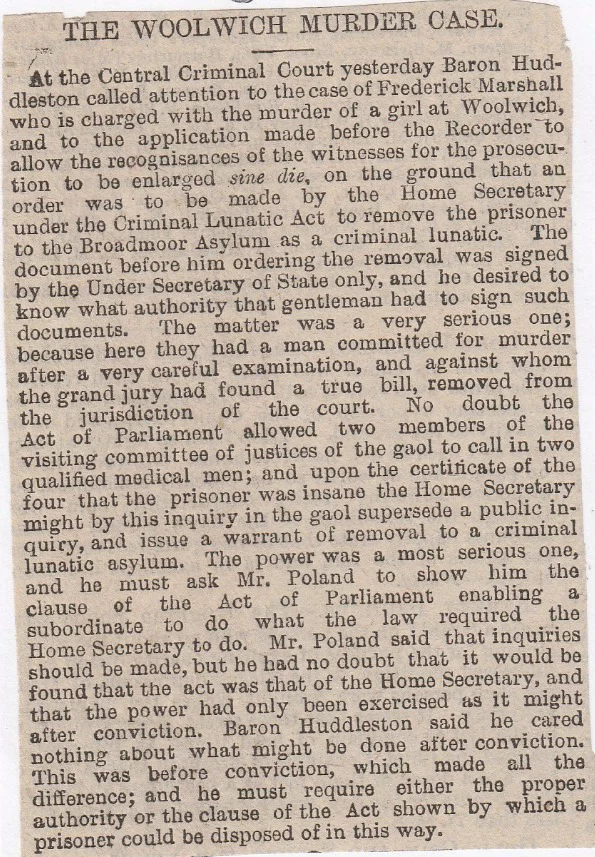
37/ Shrapnel Barracks, Woolwich Common, August 1904 (Murder/Suicide)
An artilleryman was found dead at Shrapnel Barracks, and a young lady who was thought to be his girlfriend was found with terrible gunshot wounds. She is in Plumstead Infirmary in a precarious condition and is not expected to pull through. He is a corporal named Bugden of the Royal Field Artillery and was found with part of his face blown away by the rifle that lay by his side. The couple were engaged, and were due to get married in a couple of months time, and were both in their mid-twenties. Bugden shot his good-looking fiancee in the face, hitting her in the eye. (What was it about?)
38/ Royal Albert Docks Fatality, Woolwich, September 1885.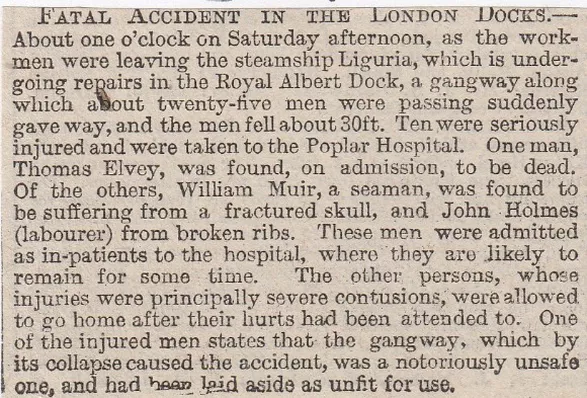
39/ Woolwich Arsenal/River Thames, September 1886 (Drownings)
A group of boys were bathing in the River Thames off Woolwich Arsenal when two of them got into difficulties. James Bayne aged twelve and Daniel Selves also aged twelve were flapping their arms in the water as Thames River police rushed to help them, but they both disappeared under the water just as they got there.
40/ Greenwich Baby Farming, July 1870
41/ Plumstead (Death in “The Peculiar People”) July 1870
42/ Royal Arsenal, Woolwich (Fatal Accident) September 1870.
Yesterday afternoon, a fatal accident occurred in the Royal Arsenal at Woolwich. A man named William Walsh was engaged, with a number of others, taking coals from the wharf to the Royal Carriage Dept; on the coals being landed they are drawn into trucks along a tramway to their destination, where they are raised by hydraulic lifts and emptied into the coal hoppers. Walsh was assisting to unload the trucks and by some means got jammed between two trucks. He was at once conveyed to the infirmary, where everything possible was done to alleviate his sufferings, but at half past five he died from the injuries received. The deceased, who was employed in the Storekeeper’s Department, was thirty-five years of age and has left a wife and four children.
43/ Fatal Boat Collision, Woolwich September 1870. (Six Killed)
44/ Fatal Shooting, Blackheath. August 1870. (Was this at The Paragon? Nice houses there!)
45/ Greenwich Murder, September 1870. (John Tantenny of 2, Munyards Row, Roan St, Greenwich. Roan St is off Greenwich High Street)
46/ Factory Fatality, North Woolwich, October 1870
47/ Greenwich Manslaughter, October 1870
48/ Secret Revealed by Death, Greenwich. December 1903.
A strange story was unfolded at Greenwich on Monday. An inquiry was held into the death of a person known for a long time as Elizabeth Barry, who was found in a roadway seriously ill and was sent to the infirmary, where an examination revealed that “she” was a “he”, and not a woman but a man. A verdict that death was due to bronchitis and alcoholism was returned.
49/ Woolwich Explosion Inquest, June 1903.
50/ Infanticide at Lea, Greenwich. November 1903. (Accused Himself of Crime)
51/ Housekeeper Murders Her Mistress, Plumstead. November 1904
52/ Fatal Cab Accident, Greenwich. March 1904.
About 5 o’clock last night a horse attached to a cab which was being driven through Greenwich Park took fright and dashed down King William St. towards Greenwich Pier. When the vehicle was nearly opposite the Seaman’s Hospital it came into collision with a lamp-post and was smashed. Its occupants were thrown violently out into the road. Willie Davis, aged six, of West Ferry Road, Millwall, was killed, his skull being fractured, and Mrs Ruggles, of Bradshaw Cottages, West Ferry Road, was so badly injured that she died shortly after admission into the hospital. The boy’s mother and other occupants were not seriously hurt. The driver jumped off the cab before the collision.
53/ Railway Decapitation at Blackheath, January 1904. (Suicide or Accident?)
54/ Explosion Kills Two, East Greenwich. December 1906 (Boiler explosion at generating station)
55/ Lady Scalded to Death, Blackheath. November 1880
56/ Woman Burnt to Death in Plumstead. December 1880
